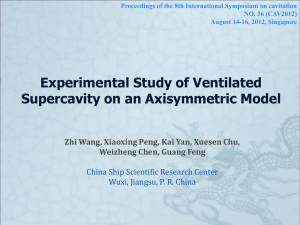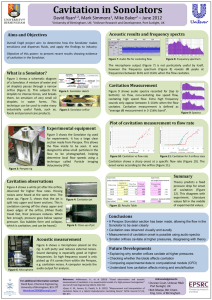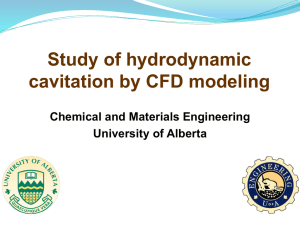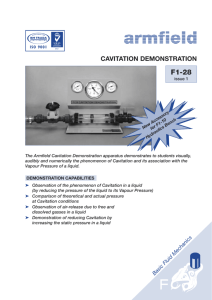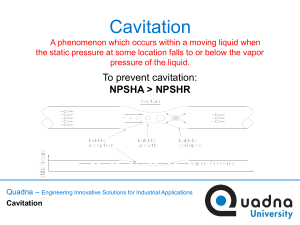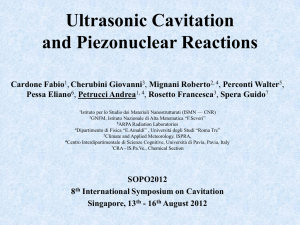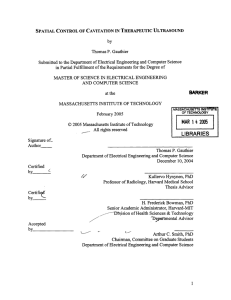The Case for cavitation induced hEATING
advertisement
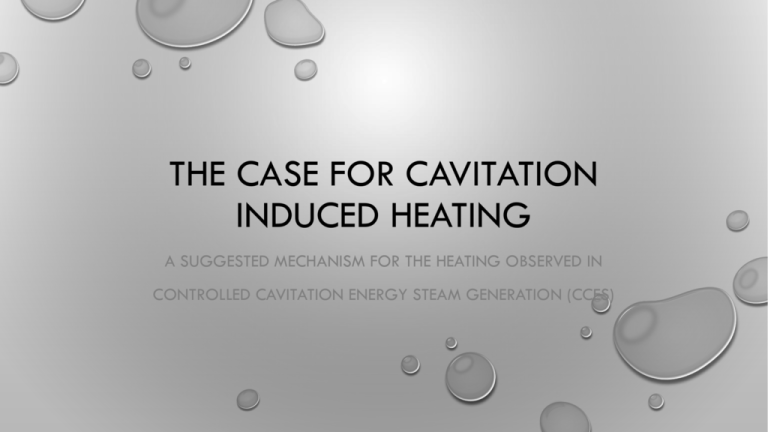
THE CASE FOR CAVITATION INDUCED HEATING A SUGGESTED MECHANISM FOR THE HEATING OBSERVED IN CONTROLLED CAVITATION ENERGY STEAM GENERATION (CCES) THE CASE FOR MIST AND CAVITATION Where Does the Heat Come From? • • • • • • Energy balance alone cannot account for the observed levels of heating. Heat output cannot exceed hydraulic kinetic energy input. Release of hydrogen bonding energy (23KJ/mole) cannot explain the observed heating. Electrolysis likely not responsible for observed Oxy Hydrogen disassociation. Temperatures above 3000°K required for 50% covalent disassociation. Cavitation is the only (non-nuclear) physical process capable of generating such heat levels. WHAT CAUSES CAVITATION ? • CAVITATION OCCURS IF THE LOCAL PRESSURE DROPS BELOW THE VAPOR PRESSURE OF THE LIQUID AT LOCAL TEMPERATURES. • THE HIGH PRESSURE DROP ACROSS THE INJECTION NOZZLE TENDS TO ACCELERATE THE LIQUID WITHIN THE SMALL NOZZLE HOLES. THIS ACCELERATION OF LIQUID INSIDE THE NOZZLE THEREBY GENERATES A HIGH LEVEL OF TURBULENCE, WHICH HAS AN INSTABILITY EFFECT ON THE JET LEAVING THE NOZZLE EXIT. • AT THE SHARP EDGES INSIDE THE NOZZLE HOLES, SUCH AS THE INLET OF THE NOZZLE HOLE, THE STREAMLINES ARE CONTRACTED SUCH THAT THE EFFECTIVE CROSS SECTION OF THE FLOW IS REDUCED LEADING TO ACCELERATED VELOCITY OF THE LIQUID. • ACCORDING TO BERNOULLI PRINCIPLE, THIS CAUSES A REDUCTION IN THE LOCAL STATIC PRESSURE AND IT CAN REACH VALUES AS LOW AS THE VAPOR PRESSURE OF THE LIQUID. FUEL INJECTORS & CAVITATION • Flow inside injection system and the nozzle is highly unsteady and cavitating • Ejection fraction is saturated with cavitation bubbles Video complement of Fluid Research - Computational Fluid Dynamic software (CFD). THEORETICAL BACKGROUND FOR FUEL INJECTOR CAVITATION CAVITATION IN INJECTOR NOZZLE HOLES - A PARAMETRIC STUDY Balaji Mohan, Wenming Yang and Siawkiang * Chou Department of Mechanical Engineering, National University of Singapore, 9 Engineering Drive 1, 117576, Singapore *E-Mail: mpeywm@nus.edu.sg (Corresponding Author) ABSTRACT: The fuel injection system in diesel engines has a consequential effect on the fuel consumption, combustion process and formation of emissions. Cavitation and turbulence inside a diesel injector play a critical role in primary spray breakup and development processes. Thus understanding the phenomenon of cavitation is significant in capturing the injection process with accuracy. In this study, the cavitating flow inside an injector nozzle hole was numerically investigated. The two-phase mixture model by Schnerr and Sauer (2001) was adopted along with k-ε turbulence model and Fluent CFD package was used to solve the governing equations numerically. THE ENERGY OF CAVITATION • Collapsing cavitation bubbles release enormous heat energy. • Cavitation routinely damages machinery and is an unwanted side effect. • Observation of light pulses emitted by collapsing cavitation bubbles revealed unexpectedly extreme conditions within the collapsing bubble cores. • Temperatures in excess of 30,000K (5 times hotter than the surface of the sun) have been measured directly and even higher Temperatures (in millions degrees K) have been inferred (Flannigan & Suslick, 2010). Cavitation damage is most commonly observed in rotating machinery. Impellers, propellers and turbines. Significant engineering resources have been applied towards eliminating this type of damage; however there has never been a practical way of harnessing this energy, although vast funds of have been invested to a accomplish this result with no practical outcome. (UNTIL THE ADVENT OF MIST) WHAT HAPPENS WHEN THE EJECTION FRACTION COLLIDES WITH THE IMPACT CHAMBER SURFACE • The gas bubble in the expanding cloud of injector vapor collides with the Surface geometry of the impact chamber • The impact chamber is very close to the output of the injector • The cloud of bubbles within the water droplet impacts the surface of the impact chamber normal to its surface. • At the moment of impact the droplet experiences a shockwave with a rapidly moving shock front. • Within the droplet computed and observed water hammer pressures on the order of (45,000 psi) Super computing record with bubble crushes these bubbles. As they collapse energy is released. collapse simulation IMPACT CHAMBER GEOMETRIES ESSENTIAL AND ENERGIES RELEASED CONSIDERABLE • Hong-Hui et al. (Wear 186-187 (1995)) Found that impact pressures for hypersonic water jets were Dependent on distance and angle of impact. The kinetic energy of the implosion grows as a cube of the maximum bubble radius Rmax: E = 4/3 π Rmax3 Pmax (1) where Rmax – is the maximum bubble radius and Pmax is theliquid pressure during the collapse phase (constant pressure is assumed). What makes this energy concentrating process useful is that this energy can be focused onto a minuscule amount of gas trapped in the initially small (micron-size) gas bubble .From the equation of state for an ideal gas: P0 V0 = N kB T0 (2) where P0 – initial bubble gas pressure, V0 = 4/3 π R03 is the initial bubble volume, N – number of atoms of gas in the bubble, kB – Bolzmann constant, T0 – initial bubble gas temperature, we can estimate maximum energy concentration per atom of gas (Ea) as Ea = (kB T0)-1 (Rmax/R0)3 Pmax/P0 THE INITIAL EVIDENCE • DURING OUR FIRST TESTS HEAT INCREASED FROM 375 DEGREES F TO 575 DEGREES F IN 2 SECONDS. • INSTANTANEOUS CHANGE OF STATE FROM LIQUID TO GAS IN MILLISECONDS OUR EXPERIMENTAL EVIDENCE CONFIRMS THIS Oxy-hydrogen explosions at 900 psi and 620 degrees F CONTROLLING CAVITATION IS THE KEY TO OUR ENERGY FUTURE • No commercial inventions exist that functionally harness cavitation • MIST is the only system capable of instantaneously producing steam on demand with significantly less energy than conventional Rankine Cycle heating • Cavitation is the only way to generates these temperatures short of Low Energy Nuclear Reactions (LENR) • CCES is the only steam based system which creates a usable source of energy through a mechanical process rather than internal or external combustion. • CCES uses modern technologies only now available that are financially viable (ie. Common rail piezo injectors, computer Controllers, ultra high pressure pumps, carbon fiber and ceramics) • CCES impacts almost every aspect of modern living. Power generation, transportation, desalination, heating, refrigeration, shipping

